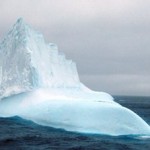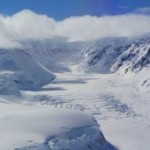 Small changes in the temperature of the Southern Ocean can contribute to far-reaching changes on the Antarctic ice sheet that could lead to future sea-level rise, new research from Victoria University has found.
Small changes in the temperature of the Southern Ocean can contribute to far-reaching changes on the Antarctic ice sheet that could lead to future sea-level rise, new research from Victoria University has found.
The researchers have revealed that sea temperatures don’t just affect the margins of the large Antarctic ice sheet, but a close connection exists between the Southern Ocean and the interior of the ice sheet, through narrow corridors of fast moving ice, known as ice streams.
The study, published online on September 17 in the Proceedings of the National Academy of Sciences journal, was led by Dr. Nicholas Golledge, a Senior Research Fellow at Victoria University’s Antarctic Research Centre, with colleagues from Victoria University and Dr. Chris Fogwill from the University of New South Wales (UNSW).
Using a new continental-scale ice sheet model, which operates at a much higher resolution than has previously been possible, Dr. Golledge and his colleagues have been able to demonstrate that large sectors of the ice sheet are highly sensitive to even small changes in the Southern Ocean.
“We found that the ice streams, which are like arteries of flowing ice, are capable of triggering rapid, significant changes right through to the interior of the ice sheet,” says Dr. Golledge.
Kevin Buckley from the School of Engineering and Computer Science helped implement the ice-sheet model code on national supercomputing facilities and on the Victoria University Science Faculty’s high performance computing facility.
The researchers then ran model simulations and compared the results with geological reconstructions of the ice sheet as it would have been 20,000 years ago, during the last glacial maximum. By doing so, they were able to analyze the effects of ocean warming and sea-level rise across the entire Antarctic ice sheet.
The results showed that while glacier accelerations triggered by changes in the Southern Ocean are relatively localized, the extent of the ice-sheet thinning which also occurs is far more wide-spread.
The research also showed that certain areas of Antarctica are more susceptible than others to changes in ocean temperatures. The fast-flowing glaciers in the Weddell Sea, the Amundsen Sea, the central Ross Sea and the Amery Trough responded most quickly to ocean changes.
The finding is important because melting of the polar ice sheets has been one of the key uncertainties in predicting future sea-level rise, and these results imply a rapid response from the ice sheet as the ocean around Antarctica warms, says Dr. Golledge.
Eighty percent of the heat from global warming has been taken up by the ocean and much of this warming is in the Southern Ocean around Antarctica. Present observations show that these warm ocean currents are already melting the marine margin of the ice sheet in the Amundsen Sea, says Dr. Golledge.
“The ice sheets lock up vast quantities of water, which has the potential to raise global sea levels by metres, but how fast this will happen remains an open question.”
“Reducing the uncertainty about future sea-level rise due to Antarctic ice sheet loss is critical, and our research is helping to achieve this.”
Dr. Golledge, who has regularly visited Antarctica to carry out field work, will head out to the ice again in a month’s time. He will be conducting further work on Antarctica’s surface geology, with the aim of obtaining geological evidence for how the ice flow changed during the last glacial maximum.
Details of the Study:
Source: Victoria University of Wellington, New Zealand.













